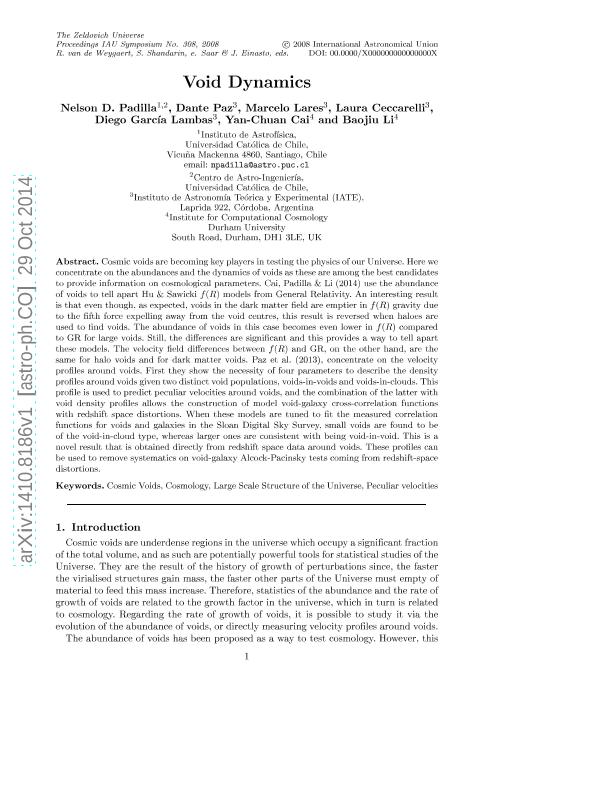Mostrar el registro sencillo del ítem
dc.contributor.author
Padilla, Nelson David

dc.contributor.author
Paz, Dante Javier

dc.contributor.author
Lares Harbin Latorre, Marcelo

dc.contributor.author
Ceccarelli, Maria Laura

dc.contributor.author
Garcia Lambas, Diego Rodolfo

dc.contributor.author
Cai, Yan-Chuan
dc.contributor.author
Li, Baojiu
dc.date.available
2022-12-29T12:31:26Z
dc.date.issued
2014-06
dc.identifier.citation
Padilla, Nelson David; Paz, Dante Javier; Lares Harbin Latorre, Marcelo; Ceccarelli, Maria Laura; Garcia Lambas, Diego Rodolfo; et al.; Void dynamics; Cambridge University Press; Proceedings of the International Astronomical Union; 11; 6-2014; 530-537
dc.identifier.issn
1743-9221
dc.identifier.uri
http://hdl.handle.net/11336/182792
dc.description.abstract
Cosmic voids are becoming key players in testing the physics of our Universe. Here we concentrate on the abundances and the dynamics of voids as these are among the best candidates to provide information on cosmological parameters. Cai, Padilla & Li (2014) use the abundance of voids to tell apart Hu & Sawicki f(R) models from General Relativity. An interesting result is that even though, as expected, voids in the dark matter field are emptier in f(R) gravity due to the fifth force expelling away from the void centres, this result is reversed when haloes are used to find voids. The abundance of voids in this case becomes even lower in f(R) compared to GR for large voids. Still, the differences are significant and this provides a way to tell apart these models. The velocity field differences between f(R) and GR, on the other hand, are the same for halo voids and for dark matter voids. Paz et al. (2013), concentrate on the velocity profiles around voids. First they show the necessity of four parameters to describe the density profiles around voids given two distinct void populations, voids-in-voids and voids-in-clouds. This profile is used to predict peculiar velocities around voids, and the combination of the latter with void density profiles allows the construction of model void-galaxy cross-correlation functions with redshift space distortions. When these models are tuned to fit the measured correlation functions for voids and galaxies in the Sloan Digital Sky Survey, small voids are found to be of the void-in-cloud type, whereas larger ones are consistent with being void-in-void. This is a novel result that is obtained directly from redshift space data around voids. These profiles can be used to remove systematics on void-galaxy Alcock-Pacinsky tests coming from redshift-space distortions.
dc.format
application/pdf
dc.language.iso
eng
dc.publisher
Cambridge University Press
dc.rights
info:eu-repo/semantics/openAccess
dc.rights.uri
https://creativecommons.org/licenses/by-nc-sa/2.5/ar/
dc.subject
COSMIC VOIDS
dc.subject
COSMOLOGY
dc.subject
LARGE SCALE STRUCTURE OF THE UNIVERSE
dc.subject
PECULIAR VELOCITIES
dc.subject.classification
Astronomía

dc.subject.classification
Ciencias Físicas

dc.subject.classification
CIENCIAS NATURALES Y EXACTAS

dc.title
Void dynamics
dc.type
info:eu-repo/semantics/article
dc.type
info:ar-repo/semantics/artículo
dc.type
info:eu-repo/semantics/publishedVersion
dc.date.updated
2022-12-06T17:26:48Z
dc.identifier.eissn
1743-9213
dc.journal.volume
11
dc.journal.pagination
530-537
dc.journal.pais
República Checa

dc.description.fil
Fil: Padilla, Nelson David. Pontificia Universidad Católica de Chile; Chile. Universidad Nacional de Córdoba. Observatorio Astronómico de Córdoba; Argentina. Consejo Nacional de Investigaciones Científicas y Técnicas; Argentina
dc.description.fil
Fil: Paz, Dante Javier. Consejo Nacional de Investigaciones Científicas y Técnicas. Centro Científico Tecnológico Conicet - Córdoba. Instituto de Astronomía Teórica y Experimental. Universidad Nacional de Córdoba. Observatorio Astronómico de Córdoba. Instituto de Astronomía Teórica y Experimental; Argentina
dc.description.fil
Fil: Lares Harbin Latorre, Marcelo. Consejo Nacional de Investigaciones Científicas y Técnicas. Centro Científico Tecnológico Conicet - Córdoba. Instituto de Astronomía Teórica y Experimental. Universidad Nacional de Córdoba. Observatorio Astronómico de Córdoba. Instituto de Astronomía Teórica y Experimental; Argentina
dc.description.fil
Fil: Ceccarelli, Maria Laura. Consejo Nacional de Investigaciones Científicas y Técnicas. Centro Científico Tecnológico Conicet - Córdoba. Instituto de Astronomía Teórica y Experimental. Universidad Nacional de Córdoba. Observatorio Astronómico de Córdoba. Instituto de Astronomía Teórica y Experimental; Argentina
dc.description.fil
Fil: Garcia Lambas, Diego Rodolfo. Consejo Nacional de Investigaciones Científicas y Técnicas. Centro Científico Tecnológico Conicet - Córdoba. Instituto de Astronomía Teórica y Experimental. Universidad Nacional de Córdoba. Observatorio Astronómico de Córdoba. Instituto de Astronomía Teórica y Experimental; Argentina
dc.description.fil
Fil: Cai, Yan-Chuan. University of Durham; Reino Unido
dc.description.fil
Fil: Li, Baojiu. University of Durham; Reino Unido
dc.journal.title
Proceedings of the International Astronomical Union
dc.relation.alternativeid
info:eu-repo/semantics/altIdentifier/url/http://adsabs.harvard.edu/abs/2016IAUS..308..530P
dc.relation.alternativeid
info:eu-repo/semantics/altIdentifier/doi/http://dx.doi.org/10.1017/S1743921316010528
Archivos asociados
